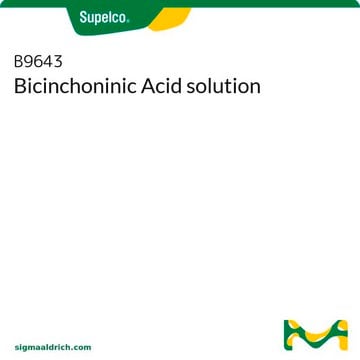BCA1
Bicinchoninic Acid Kit for Protein Determination
for 200-1000 μg/ml protein
Synonym(s):
BCA protein assay
About This Item
Recommended Products
usage
sufficient for ~500 assays
storage temp.
2-8°C
Application
Features and Benefits
- Simple, sensitive colorimetric assay for proteins
- Two stable reagents are used for the working solution
- Faster and easier than the Lowry protein assay
- Compatible with many detergents both ionic and nonionic
- Less variation between different proteins than the Bradford dye-binding assay
- Adaptable for use in microwell plates
Principle
Kit Components Only
- Bicinchoninic Acid Solution 1 L
- 4%(w/v) CuSO4 · 5H2O Solution 25 mL
- Protein Standard Solution 5 x 1
Signal Word
Danger
Hazard Statements
Precautionary Statements
Hazard Classifications
Aquatic Acute 1 - Aquatic Chronic 1 - Eye Dam. 1 - Met. Corr. 1
Storage Class Code
8A - Combustible corrosive hazardous materials
Flash Point(F)
Not applicable
Flash Point(C)
Not applicable
Personal Protective Equipment
Certificates of Analysis (COA)
Search for Certificates of Analysis (COA) by entering the products Lot/Batch Number. Lot and Batch Numbers can be found on a product’s label following the words ‘Lot’ or ‘Batch’.
Already Own This Product?
Find documentation for the products that you have recently purchased in the Document Library.
Customers Also Viewed
Related Content
Products for traditional and alternative protein quantitation techniques available, including BCA, Bradford, Lowry, and more.
Products for traditional and alternative protein quantitation techniques available, including BCA, Bradford, Lowry, and more.
Products for traditional and alternative protein quantitation techniques available, including BCA, Bradford, Lowry, and more.
Products for traditional and alternative protein quantitation techniques available, including BCA, Bradford, Lowry, and more.
Our team of scientists has experience in all areas of research including Life Science, Material Science, Chemical Synthesis, Chromatography, Analytical and many others.
Contact Technical Service










